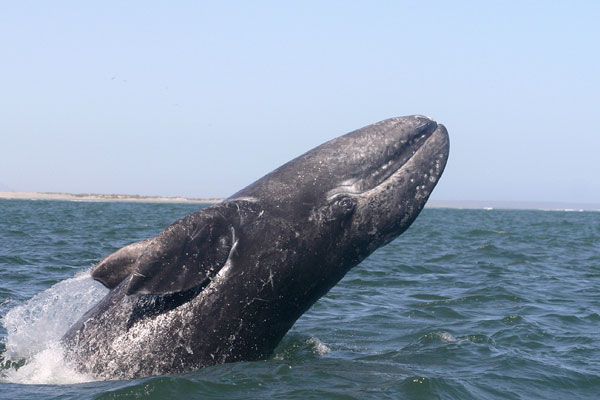The Gray Whale

Find A Hotel in Los Cabos
Fantastic deals on hotels in Los Cabos with our booking partners. Amazing discounts on over 100 properties, instant reservation and user reviews/ratings to guarantee you get the hotel you want, when you want it. In many cases you PAY NOTHING now...check it out here!
This is the iconic whale to see in the waters around Cabo San Lucas.
The annual migration which takes place between November and March, at 6000 miles the longest migration of any mammal, is a wildlife spectacle on the same scale as the wildebeest migration of the Serengeti. These beautiful mammals migrate to their breeding ground each year and pass within a stone's throw of the many beaches between Todos Santos and Cabo San Lucas. They have even been seen in the bay at Medano beach, causing chaos among the water taxis as they jockey to get their clients ever closer.
Gray whales journey from their summer homes in the Bering and Chukchi Seas
between Alaska and Siberia to winter in the warm waters of Baja
California and the Sea of Cortez. Averaging a speed of four to five
knots, they arrive from November thru December seeking both shelter from
the frigid northern waters and refuge to birth their young. Gray whales
(also known as the Pacific gray, California gray or grayback) calve in
the protected, shallow lagoons of San Ignacio, Scammon’s, Ojo de Liebre
and Magdalena Bay.
Gray whales feed mostly on the bottom on tiny
shrimp-like animals called amphipods although when krill is plentiful
they will gorge on that closer to the surface, however they rarely feed
during their migration to the Baja. They are the only bottom feeding
whale and are placid shore lovers who spend most of their lives
traveling. Once found in Europe and Asia, the Gray population is now
confined to the North Pacific, from Siberia and Alaska south to Mexico,
although for the first time in several centuries a Gray whale has been
found in the Mediterranean Sea. Scientists think that due to climate
change the Northwest Passage is now allowing some of these mammals to
alter their migration routes.
Like all mammals, the Gray whale is warm blooded, breathes air and
nurses its young. Moderately large in size, they range in length from 40
to 50 feet and can weigh up to 73,000 pounds, with males smaller than
females. Gray in color, hence the name, they are classified as Cetacea,
marine mammals that include whales, porpoises and dolphins and belong to
Mysticeti, one of the three families of great baleen whales.
Grays have
no close relatives; they are the single species of the family
Eschrichtidae. Grays, Right whales and the family of Fin, Blue, Sei,
Bryde’s, Minke and Humpback whales (balaenopterids) all have baleen
fringes, made of whalebone, instead of teeth. The baleen lines the upper
jaw and works like a large comb, filtering plankton (and in some cases
small fish) from salt water and, in the Grays’ particular case,
sediment. When the whale’s mouth is full it closes and forces the water
out, catching the plankton in the baleen. When all of the residue is
filtered, the whale swallows the bolus of nutritious plankton. They can
remain under water for fifteen minutes before running out of air,
cutting great grooves in the silt as they feed. Grays are characterized
by a long snout and double blowhole on top of their head. In place of a
dorsal fin, the Gray whale has a hump with dorsal ridges running to its
flukes (tail).
The lagoons frequented by the Grays are
mid-way to three-quarters of the way down the Baja peninsula and offer
optimal conditions for female Grays to give birth. After a gestation
period of thirteen months, newborn whales enter the world about 15 feet
long and weigh around 1,500 pounds.
Whale milk is more than 50% fat and
10 times richer than cow’s milk, allowing the calf to build up blubber
for the long return trip north in the spring. Mother Grays are extremely
affectionate, playing constantly and bracing the calf on her back when
it needs to rest. In the sheltered lagoons, the calves learn survival
skills and build their muscles by swimming against the ocean currents
flowing into the calmer waters. The calves weigh around 3,000 pounds and
are about 19 feet long when they are ready to leave the lagoon.
The
Gray’s natural predators are sharks and Orcas (killer whales) which are
both present in the waters around Cabo, so mother Grays are always on
guard. All the elder Grays carry scars and tooth rake marks from
encounters with Orcas. You will also see light gray or white scars where
the whale barnacles have fallen off. Youngsters develop barnacle
patches soon after birth.
If you visit Cabo during the migration period you will almost certainly see these wonderful animals from the beach on the Pedregal/Finesterra side. Visit Divorce Beach and you will most likely be lucky, but the best option is always to find a tour company which you can do right here on iTravel.